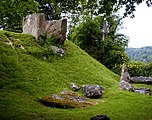From today's featured articleThe Coldrum Long Barrow is a ruined British Early Neolithic chambered long barrow near the village of Trottiscliffe, Kent. Probably constructed in the fourth millennium BCE, it was built by pastoralist communities soon after the introduction of agriculture to Britain. Built out of earth and around fifty local sarsen-stone megaliths, the barrow consisted of a tumulus enclosed by kerb-stones. At the eastern end of the tumulus was a stone chamber containing the remains of at least seventeen human bodies, at least one of which had been dismembered before burial, potentially reflecting a tradition of excarnation and secondary burial. The long barrow later became dilapidated, possibly exacerbated through deliberate destruction by iconoclasts or treasure hunters. Local folklore associates the site with the burial of a prince and the countless stones motif. Excavations took place in the early 20th century, and in 1926, ownership was transferred to the National Trust. Entry is free, and the stones are the site of various modern Pagan rituals. (Full article...)
Recently featured:
Did you know ... Kogin-zashi patterns on items from Aomori Prefecture
|
In the news
On this dayJanuary 18: Royal Thai Armed Forces Day in Thailand (1593)
Isabella Jagiellon (b. 1519) · Jeanne Quinault (d. 1783) · N. T. Rama Rao (d. 1996)
More anniversaries:
|
Today's featured picture

|
Reverse genetics is a method in molecular genetics that is used to help understand the function of a gene by analysing the phenotypic effects of specific nucleic acid sequences after being genetically engineered. The process usually proceeds in the opposite direction to so-called forward genetic screens of classical genetics. In other words, while forward genetics seeks to find the genetic basis of a phenotype or trait, reverse genetics seeks to find what phenotypes arise as a result of particular genetic sequences. For instance, such procedures allow scientists to manipulate the genomes of influenza viruses by transferring genes between different strains. The novel genotypes of the viruses produced in this way have greatly diminished pathogenic potency but can still induce protective immunity in a host. Using this technique, vaccines can be created, as illustrated in this diagram depicting the development of an avian flu vaccine. Diagram credit: Mouagip
Recently featured:
|
Other areas of Wikipedia
- Community portal – Bulletin board, projects, resources and activities covering a wide range of Wikipedia areas.
- Help desk – Ask questions about using Wikipedia.
- Local embassy – For Wikipedia-related communication in languages other than English.
- Reference desk – Serving as virtual librarians, Wikipedia volunteers tackle your questions on a wide range of subjects.
- Site news – Announcements, updates, articles and press releases on Wikipedia and the Wikimedia Foundation.
- Village pump – For discussions about Wikipedia itself, including areas for technical issues and policies.
Wikipedia's sister projects
Wikipedia is hosted by the Wikimedia Foundation, a non-profit organization that also hosts a range of other projects:
Free media repository
Wiki software development
Wikimedia project coordination
Free textbooks and manuals
Free knowledge base
Free-content news
Collection of quotations
Free-content library
Directory of species
Free learning materials and activities
Free travel guide
Dictionary and thesaurus


